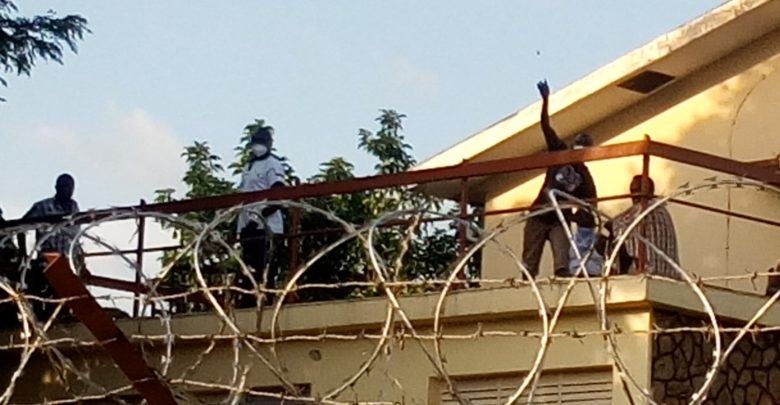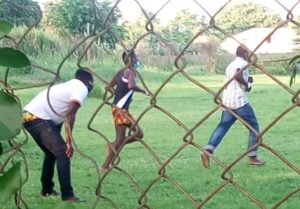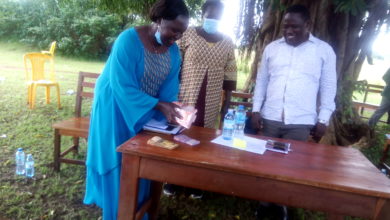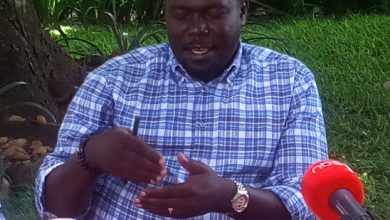
Global Politics
UGANDA: COMMUNITY SURROUNDED FOUR SUSPECTED COVID-19 IN GULU, 20 SUDANESE COVID-19 PATIENTS BROUGHT TO UGANDA
The new site for treatment center at Gulu School of Health Science where COVID-19 patients are, there is open space for free movement
The situation in Gulu City, Northern Uganda is become dire following high numbers of COVID-19 pandemic admission in Gulu Regional Referral Hospital, the fear has engulf Gulu City as many are contemplating for what next to do.
Others fear that the high numbers truck drivers including 2 people from community who has been their contact at Elegu boarder point although they are admitted at Gulu school Clinical Officers, their present put Gulu City residence at risk.

GULU-UGANDA: Uganda has become a beacon of hope according to regional intelligence from the Great Lakes Region source says 20 nationality who are victims of COVID-19 pandemic from South Sudan has been brought to Uganda, 8 of them were transfer from Juba to Kampala and 12 people are admitted in Gulu Regional Referral Hospital, regional intelligence sources intimates.
There is public fatigue taking tolls and people are planning for mob justice as many vehicle are smuggling suspected cases of COVID-19 people from Elegu boarder point. The people who being smuggle are believe to be positive with corona virus.
Akot Mary an old women from Layibi round about 4 kilometre from Gulu City along Kampala High way she was back nesting a baby boy, shouted to a Reature photo journalist, look at those three people, pointing to three people shaken men who had just jumped off from a Double Cabin pick up.
Akena the journalist again ask her, “Why people are standing in woeful manner.” Akot, the old woman says we fear that those stranger will bring for us the COVID-19.
James Akena narrated to Oyeng Yeng News that when he learned what is taking place and saw how the driver of Double Cabin pick up how he was behaving with the police traffic officer, to his mind it seem that some thing is fishy , the way driver was talking to police man who were at the check point.
He move toward them, and instead ask the traffic police officer, why people are shouting that those three men have just jumped out of the pick up.
However, traffic police officer was trying to ignore him.
But, “Immediately he shouted that those people you see them just jumped out of this truck, the truck driver you are talking is transporting them.
To back up his argument unfortunately, one person took off at supersonic speed toward Kampala passing the traffic police officer and the truck driver, but the boda baoda follow him he was surrounded.
“The boda boda motor rush and surrounded the fleeing man, I phone Gulu COVID-19 Task Force, immediately the task force came with bottle of jig and jigged him, all of them was put in the waiting Ambulance.” the community at work?
The cries of COVID-19 patients admitted at Gulu Regional Referral Hospital
Road users along the main streets Andrea Olal road which start from Acholi Inn round about are in trouble, COVID-19 patients just shout, “We need food, we last eat food two days ago.”
the have been hanging up on balcony of School clinical office, some of them are throwing stone to journalists who tried to take their photo.
Jacob Siminyu Spokesperson for Ministry of International when contacted about Truck driver are running away from Elegu and what is his takes?
Siminyu says he has already talks and reassure journalists from Northern Uganda Media Club that let sensitize community in Northern Uganda about the danger of those people who run away.
“Let community be vigilant, if they are aware of the people who might have been having COVID-19 then I am very happy, let them be arrested by the community. Siminyu echoes.
Adding that those CVIOD-19 who are hanging out at balcony we must report them to Regional police officer, if they do not act we must report the matter to Gulu Resident district Commissioner RDC, Maj Santos Okot Lapolo.
“Go and report to Gulu Central Police Station, if they don’t response then go to Gulu District Commissioner, we don’t have control in Gulu,we have government in place” Siminyu urged
On Sunday May 24th 2020. When addressing Northern Uganda Media Club in Gulu says the government will soon begin to provide Police escorting truck drivers back to their countries which will be up by other security apparatus.
This follow the complaint by the community along the Northern Corridor that most of the truck drivers are spreading COVID-19 by splitting on UGX 50,000 Notes, and later they throw it amidst the public.
Michael Lakony the Chairman Amuru District is one of the complainer, says that due to the reckless truck drivers who drop their used masks along the road, and bottle, they have decided to lock all the borehole along Juba road to avoid them using it.
Siminyu says the Ministry of Internal Affairs has mechanism through control room that check and monitor all the truck drivers which enter into the country and goes out of the country. “Right now Sunday 24th we have about 1,003 trucks which are too clear from South Sudan side at Nimule.” Siminyu reasoned.
When Okot Lapolo Gulu RDC was contacted, it was futile to reach him.but early on Tuesday 27, while addressing Task Force admitted that some of the patients do not eat the type of food which is eaten in Northern Uganda, they need their own meals
Why can Gulu District Authority block the road leading RDC office, and traffic use Municipality and Town Clerk access road?





